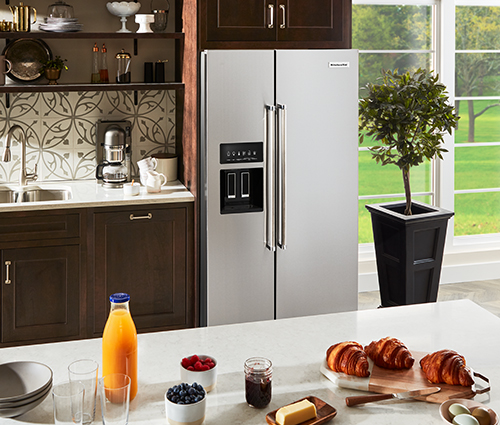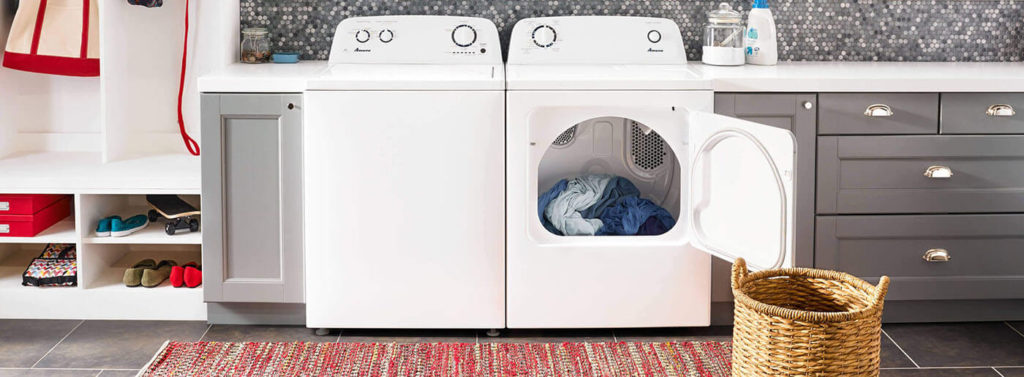If you’re considering a new refrigerator, an important choice you’ll make during the process is choosing between a free-standing or a built-in refrigerator. This guide will help you learn what the differences are.
What is a built-in refrigerator?
Built-in fridges are often favoured by homeowners who want seamless, high-end kitchen designs. Some built-ins can be flush with cabinetry, while others are non-flush so that the doors extend beyond the counter depth. Built-in fridges are also generally taller than free-standing models.
Designed for home use, these refrigerators are available in many different sizes and can be as wide as 48 ” (122 cm). However, they are generally more expensive and often require professional installation as compared to free-standing fridges.

What is a free-standing refrigerator?
Since free-standing refrigerators are the most common type of refrigerators in the home, they come in more styles and brands. They’re also commonly more affordable than built-in refrigerators.

Because they feature a stand-alone design, there is no professional installation requirement. This not only can reduce the cost, but also enables you to move the fridge more easily to clean behind it, or if service is required, it is much easier for a technician since there is no need to uninstall it.
Free-standing fridges are available in full/standard depth or counter-depth.
You can learn more about free-standing counter-depth vs standard-depth refrigerators here.
Additionally, there are a variety of width options, with the largest available width being 36 ” (91 cm).
Built-in vs. Free-standing Refrigerator
Here are some key differences between a built-in refrigerator and a free-standing refrigerator:
1. Customization: Built-in refrigerators are generally more customizable, with the ability to pair with surrounding cabinets using a panel-ready design, or stand out as a statement. Free-standing refrigerators may come in select colours, like stainless steel, black stainless steel, black, and white.
- Fully Integrated: Where the fridge will fit in seamlessly with your cabinetry.
- Non-flush/Standard: Where the doors of the refrigerator will sit beyond the cabinetry.
Consumers can select either stainless steel or custom panels that match cabinets. This is a matter of personal preference and you can refer to the manufacturer’s installation guide or specifications to learn more. Free-standing fridges, on the other hand, come in certain sizes that may require gaps to allow for airflow or door swings, thereby possibly not giving you the seamless look you desire.
3. Space: Due to their sleek design, built-in refrigerators can either be flush with the cabinets or protrude slightly, whereas free-standing refrigerators will protrude more depending on their depth. When it comes to free-standing fridges, counter-depth refrigerators will protrude less than full/standard-depth ones, giving you more room to move around your kitchen.
4. Storage/Capacity:
Free-standing fridges (full-depth) typically offer more storage capacity with a smaller footprint, whereas with a built-in, you would generally require 42 ” to 48 ” (107 cm to 122 cm) if you need more storage. Built-ins are also typically taller, usually above 80 ” (203 cm), giving you more space, but also something to consider when you are planning your kitchen design. Keep in mind that some kitchen designs may not allow for this space, plus the cost can be much higher too.

5. Planning:
Built-in refrigerators need specifically designed cabinetry, so you must carefully plan and measure the opening for the fridge you intend to use in your kitchen. When it comes to designing your kitchen, free-standing refrigerators require less planning. However, you still need to make sure that you measure your space properly so your fridge will fit into the opening in your kitchen layout.
PROS AND CONS
Here are some pros and cons of built-in vs. free-standing refrigerators, so you can decide what is the better option for you.
Built-In
Pros:
- Space (width): Built-ins can be up to 48 ” (122 cm) wide, but many free-standing fridges max out at 36 ” (91.4 cm). Being able to get a refrigerator this wide is a great option if you need more food storage space for your family.
- Premium look & feel: This type of refrigerator can blend seamlessly into your cabinets. Select models can be installed to sit flush, but if you want the appliance to blend in, you can also add a panel that matches the colour of your cabinets.

Cons:
- Space (depth): The depth of the refrigerator may be reduced. Built-in fridges are usually shallower than their free-standing counterparts. This is what allows them to sit flush or near flush with your cabinets. However, they tend to be taller, which can give you some extra space.
- Installation: Depending on how handy you are, you may need to hire professionals for the installation of the appliances, as well as the electrical work. This may include cabinet work and plumbing as well.
- Cost: The price of built-ins tends to be higher: You can expect to pay $2,199 on the lower end to upwards of $20,000+ on the higher end.
Always check and follow your appliance installation instructions and manufacturer’s recommendations before beginning, as they should be your primary source of information.
Free-standing
Pros:
- Options: With free-standing refrigerators, you can enjoy a wide variety of configurations. There are options with freezers on top, bottom, side-by-side, or a fridge with French Doors and freezer on the bottom. Some of these configurations also come in counter-depth options, so there are plenty to choose from.
- Cost: Free-standing refrigerators are typically less expensive, so if you need to keep to a budget, this is your best bet. Keep in mind that many free-standing refrigerators have top- of- the- line styles and features to get that premium look and feel, without having to get into the built-in price range. Typical prices range from $300 on the lower end to upwards of $6,000+ on the higher end.
- Flexibility: A free-standing model is great if you want the option to move it around (if your kitchen layout allows it) or if you decide to move it to the basement as a backup fridge. This appliance only needs to be close to an electrical outlet to run. Furthermore, you may take it with you if you decide to move. In order to do so, you only need to slide it out and pack it up
Cons:
- Space: If you choose a free-standing standard-depth fridge, it will typically protrude more than 6 ” (15 cm) beyond surrounding countertops. For some kitchen layouts this may not be a big deal, but it’s something you need to consider, especially if you have a smaller kitchen.
In need of a refrigerator that fits your needs? Our Refrigerator Finder makes it easy to find a refrigerator that meets your needs.





